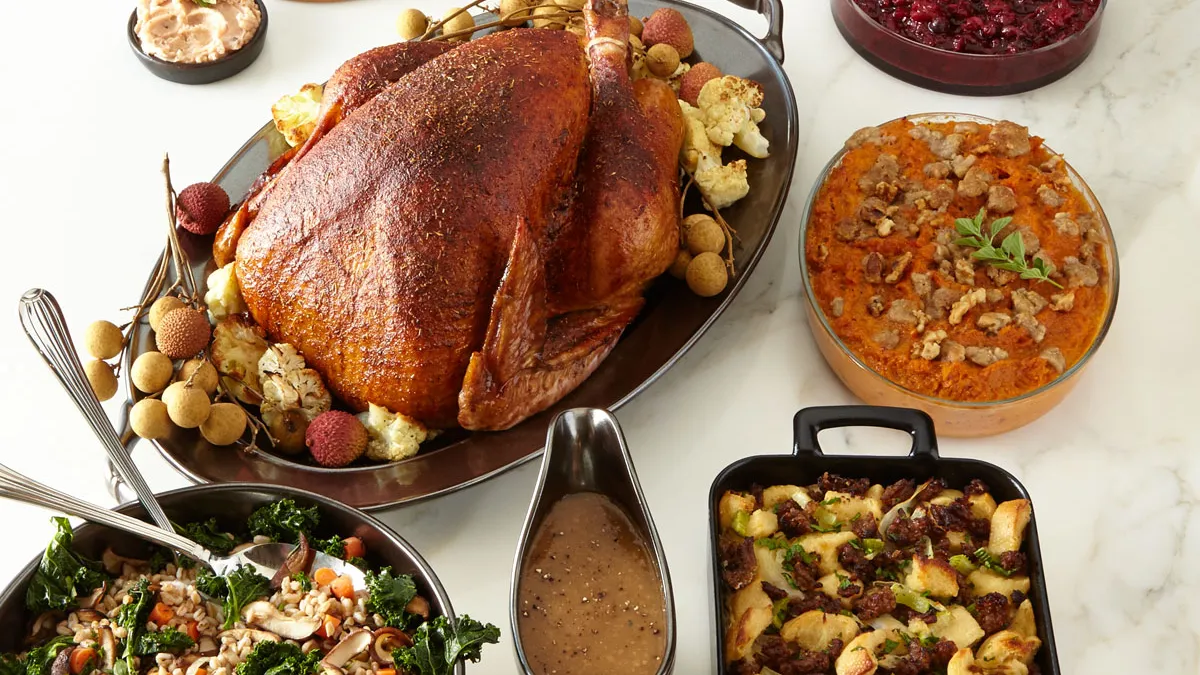Dive Brief:
- Sales of smaller turkeys are on the rise this Thanksgiving, according to Bloomberg, which reported that increased awareness of food waste as well as smaller family sizes in the United States are driving this trend.
- Although mid-sized turkeys (12-15 lbs) are still selling like hotcakes, producers like Butterball to D’Artagnan are offering miniature versions of the holiday bird. Data from the U.S. Department of Agriculture data confirm the increased demand showing inventories of whole hens, which are smaller than males, are down 8.3 percent from a year ago.
- Similarly, big, whole turkeys are not necessarily on everyone’s shopping list anymore. Vegan alternatives, quail, squab (young pigeon) and even venison are finding their way onto the holiday table. “The whole bird is not necessarily on everyone’s Thanksgiving table the way it used to be,” said Russ Whitman, a senior vice president at commodity researcher Urner Barry.
Dive Insight:
Tiny things are everywhere. From Trader Joe’s miniature avocados to the ever-more-popular tiny turkeys, small things are having a huge moment. People fawn over the cuteness factor, while others praise their utility, and while adorable may get tiny food a foothold in the market, it is the utility factor that is going to keep it there.
More and more, awareness of food waste is coming to the forefront of the consumer consciousness. Americans waste 130 million pounds of food each year, which means more food reaches landfills and combustion facilities than any other material, according to the Environmental Protection Agency. On Thanksgiving alone, about 200 million pounds of turkey finds its way into waste facilities, according to the Natural Resources Defense Council.
Recognizing the gravity of the situation, on September 16, 2015, the United States Department of Agriculture and EPA announced the first-ever domestic goal to reduce food loss and waste by half by the year 2030. And it seems that consumers have caught on. More and more consumers are purchasing products that have more of an environmental conscience and mission, which they see as premium. Since consumers are willing to pay more for products that extol these values, companies are also benefiting financially from this trend.
Looking at tiny turkeys, it is clear that customers are willing to pay for something a little smaller. Honey Baked Ham Co. has a 2.5-pound baked turkey breast for $34.95, while a full-sized 11 pound one is $49.95. D’Artagnan has a 7-pound turkey breast for $71.99, which is 79% of the cost of their full-sized 10-pound uncooked turkey.
Still, consumers are flocking toward smaller portions. Inventories of smaller birds are down 8.3% this year, according to the U.S. Department of Agriculture.
It remains to be seen if the trend towards smaller is a lasting one. However, as snacking throughout the day continues to replace the traditional three square meals, there is a good chance. Tiny desserts, slider-sized burgers and pre-prepared meals for one or two have continued to see growth. The global ready-to-eat food market is expected to exceed $195.3 billion in terms of value by 2026, according to Market Research Reports Search Engine. Even soda has seen benefits from using smaller bottles and cans, which have been popular with shoppers and allowed the soda companies to charge more per ounce.
While the tiny trend is likely to continue to attract consumers year round, the holiday season may prove to be a different beast. As it is traditionally a time when large groups of people gather around a table to share, the trend toward tiny may not have longevity. Still, if families continue to spread further apart and celebrate in their own homes, the tiny turkey trend may find that it has some staying power.















